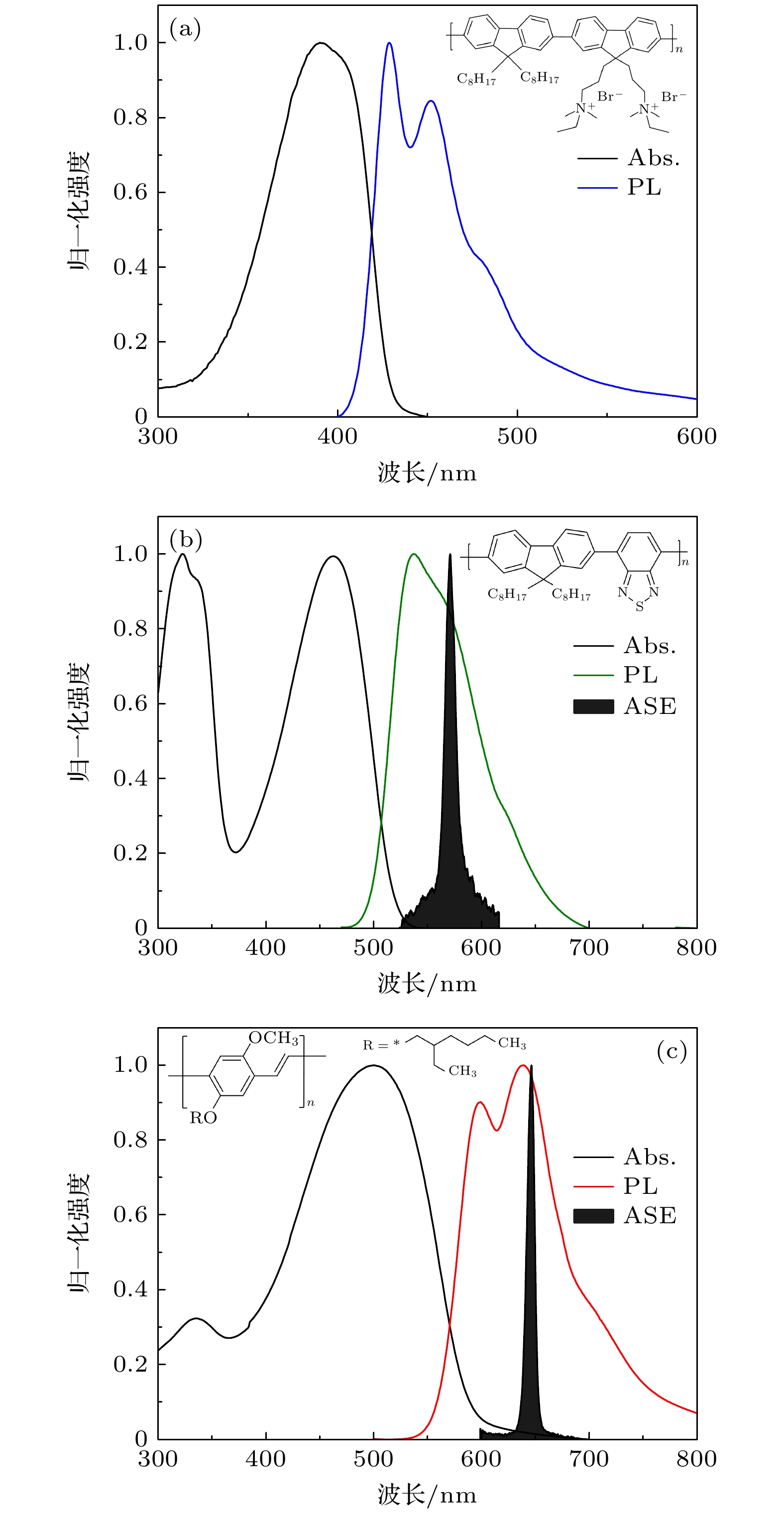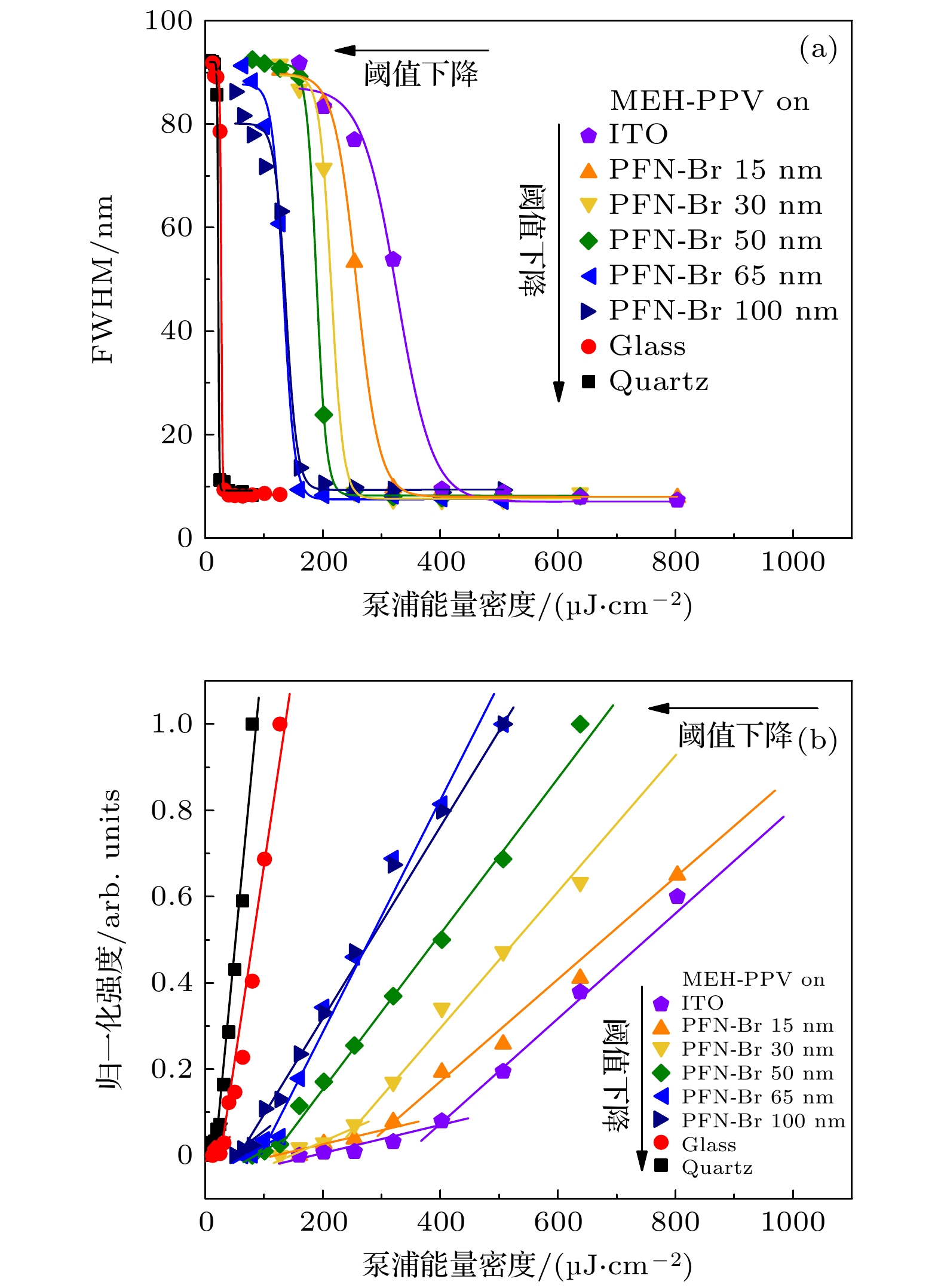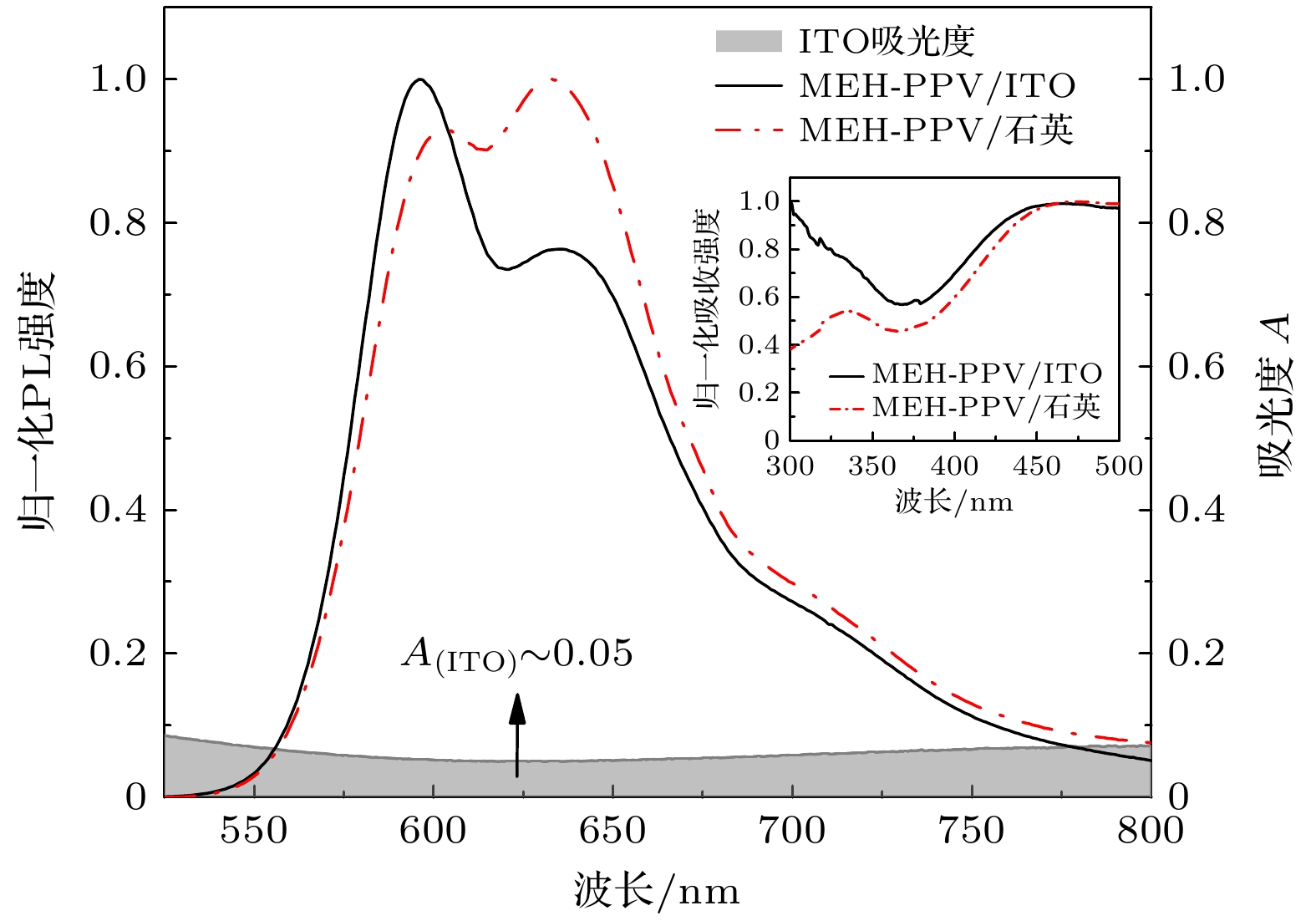-
系统研究了水/醇溶性共轭聚电解质Poly[(9, 9-bis(3′-((N, N-dimethyl)-N-ethylammonium)-propyl)-2, 7-fluorene)-alt-2, 7-(9, 9-dioctylfluorene)]dibromide(PFN-Br)的光放大性质, 发现其具有较小的放大自发辐射(ASE)阈值(~11 μJ/cm2)和ASE截止厚度(<50 nm), 是一种高效的蓝光(~456 nm)增益介质. 利用其对于有机溶剂的良好耐性, 如甲苯等, 分别在石英和ITO玻璃基底上制备了PFN-Br/F8BT以及PFN-Br/MEH-PPV双层器件. 经过研究发现, PFN-Br界面层不会明显增加系统损耗并影响上层F8BT的光增益. 然而, 在ITO玻璃基底上, 通过引入PFN-Br界面层, 减少了ITO电极对MEH-PPV增益介质损耗, 显著地降低了其ASE阈值(相比于没有PFN-Br界面降低约60%). 这些发现说明了PFN-Br本身具备良好的增益性能, 同时也是成熟的载流子传输界面功能材料, 在有机激光领域应用前景十分广泛.In this paper, the optical gain properties of the water/alcohol soluble conjugated polyelectrolyte (Poly[(9,9-bis(3′-((N,N-dimethyl)-N-ethylammonium)propyl)-2,7-fluorene)-alt-2,7-(9,9-dioctylfluorene)]) (PFN-Br) and its potential applications in future electrically pumped organic lasers are revealed and systematically studied. To the best of our knowledge, no studies on the optical gain properties of PFN-Br or its prototype, poly[(9,9-bis(3′-(N,N-dimethylamino)propyl)-2,7-fluorene)-alt-2,7-(9,9-dioctylfluorene)] have been reported before. These conjugated polyelectrolytes are widely used as the interlayers in organic light emitting diodes or organic solar cells. The thickness of such an interlayer is usually less than 10 nm, which is considered not sufficient for supporting light waveguiding. Therefore, the thickness of the PFN-Br layer used in this work is increased to more than 100 nm. Through careful study, the polymer is found to possess a low threshold of amplified spontaneous emission (ASE) (~11 μJ/cm2) and a small ASE cutoff thickness (<50 nm). It is an efficient blue emission (~456 nm) gain medium. The ASE peak of the PFN-Br film is red-shifted as the thickness increases from 50 to 220 nm. By utilizing the great resistance of PFN-Br against the organic solvent, such as toluene, PFN-Br/F8BT bilayer devices on quartz and PFN-Br/MEH-PPV bilayer devices on ITO glass are fabricated and characterized. In the PFN-Br/F8BT bilayer devices, it is found that the PFN-Br interlayer has very limited influence on F8BT. The ASE threshold of F8BT increases only twice, compared with that of F8BT monolayer device, when 100-nm-thick PFN-Br layer is introduced beneath the F8BT film. No significant change in optical gain or loss is observed. Most of the extra losses in F8BT due to the introduction of PFN-Br are attributed to the larger refractive index of PFN-Br than that of quartz substrate. Furthermore, in the PFN-Br/MEH-PPV bilayer devices on ITO glass, introducing PFN-Br interlayer resulting in optimal ASE performance of MEH-PPV compared with that on bare ITO surface. The ASE threshold of MEH-PPV is reduced as much as 60% (from 402 μJ/cm2 to 160 μJ/cm2) while the PFN-Br layer is sandwiched between ITO and MEH-PPV. The PFN-Br layer modifies the waveguiding modes, and reduces the interaction between excitons and ITO electrodes. As a result, the ASE performance of MEH-PPV is improved. The findings of this report indicate that the PFN-Br is not only a good carrier transport material but also a highly-efficient gain medium. PFN-Br, combined with its advantages in different fields, is expected to play various roles in future organic electrically pumped lasers.
-
Keywords:
- organic semiconductor laser /
- amplified spontaneous emission /
- polymeric film /
- water soluble polymer
[1] Chenais S, Forget S 2012 Polym. Int. 61 390
 Google Scholar
Google Scholar
[2] Yap B K, Xia R D, Campoy-Quiles M, Stavrinou P N, Bradley D D C 2008 Nat. Mater. 7 376
 Google Scholar
Google Scholar
[3] Kim H, Schulte N, Zhou G, Mullen K, Laquai F 2011 Adv. Mater. 23 894
 Google Scholar
Google Scholar
[4] Feng Z J, Cheng Z, Jin H X, Lu P 2022 J. Mater. Chem. C Mater. 10 4497
 Google Scholar
Google Scholar
[5] Sarma M, Chen L M, Chen Y S, Wong K T 2022 Mater. Sci. Eng. R Rep. 150 100689
 Google Scholar
Google Scholar
[6] Al-Azzawi A G S, Aziz S B, Dannoun E M A, Iraqi A, Nofal M M, Murad A R, Hussein A M 2023 Polymers 15 164
 Google Scholar
Google Scholar
[7] Li B, Yang X, Li S Y, Yuan J Y 2023 Energy Environ. Sci. 16 723
 Google Scholar
Google Scholar
[8] Wang J J, Wen S G, Hu J, Han J H, Yang C P, Li J F, Bao X C, Yan S K 2022 Chem. Eng. J. 452 139462
 Google Scholar
Google Scholar
[9] Yazdani S A, Mikaeili A, Bencheikh F, Adachi C 2022 Jpn. J. Appl. Phys. 61 074003
 Google Scholar
Google Scholar
[10] Zhang Q, Tao W W, Huang J S, Xia R D, Cabanillas-Gonzalez J 2021 Adv. Photonics. Res. 2 2000155
 Google Scholar
Google Scholar
[11] He Z C, Zhong C M, Su S J, Xu M, Wu H B, Cao Y 2012 Nat. Photonics 6 591
 Google Scholar
Google Scholar
[12] Zhao Y Y, Zhang Q W, Liu Y F, Lv C, Guo S, Liu X P, Bi Y G, Li H W, Wu Y Q 2022 Org. Electron. 109 106620
 Google Scholar
Google Scholar
[13] Feng C, Wang X J, He Z C, Cao Y 2021 Sol. RRL 5 2000753
 Google Scholar
Google Scholar
[14] Hsu F C, Lin Y A, Li C P 2021 Org. Electron. 89 106008
 Google Scholar
Google Scholar
[15] Li M Q, Jiang J X, Ning Y J, Zhao S L, Masri W F A, Wageh S, Al-Ghamdi A 2022 Synth. Met. 289 117122
 Google Scholar
Google Scholar
[16] Hu Z C, Zhang K, Huang F, Cao Y 2015 Chem. Commun. 51 5572
 Google Scholar
Google Scholar
[17] Huang F, Wu H B, Wang D, Yang W, Cao Y 2004 Chem. Mater. 16 708
 Google Scholar
Google Scholar
[18] Wu H B, Huang F, Mo Y Q, Yang W, Wang D L Peng J B, Cao Y 2004 Adv. Mater. 16 1826
 Google Scholar
Google Scholar
[19] Fu J F, Yuan L G, Ling F, Duan R M, Chen Q Y, Ma H, Zhou M, Song B, Zhou Y, Li Y F 2020 J. Power Sources 449 227474
 Google Scholar
Google Scholar
[20] Xiong X, Xue X N, Zhang M, Hao T Y, Han Z Y, Sun Y Y, Zhang, Y M, Liu F, Pei S P, Zhu L 2021 ACS Energy Lett. 6 3582
 Google Scholar
Google Scholar
[21] Ohisa S, Kato T, Takahashi T, Suzuki M, Hayashi Y, Koganezawa T, McNeill C R, Chiba T, Pu Y J, Kido J 2018 ACS Appl. Mater. Interfaces 10 17318
 Google Scholar
Google Scholar
[22] Stevens M A, Silva C, Russell D M, Friend R H 2001 Phys. Rev. B 63 165213
 Google Scholar
Google Scholar
[23] Xia R D, Heliotis G, Bradley D D C 2003 Appl. Phys. Lett. 82 3599
 Google Scholar
Google Scholar
[24] Hayes G R, Samuel I D W, Phillips R T 1997 Synth. Met. 84 889
 Google Scholar
Google Scholar
[25] Kretsch K P, Belton C, Lipson S, Blau W J, Henari F Z, Rost H, Pfeiffer S, Teuschel, A, Tillmann H, Horhold H H 1999 J. Appl. Phys. 86 6155
 Google Scholar
Google Scholar
[26] Calzado E M, Villalvilla J M, Boj P G, Quintana J A, Diaz-Garcia M A 2005 J. Appl. Phys. 97 093103
 Google Scholar
Google Scholar
[27] Anni M, Perulli A, Monti G 2012 J. Appl. Phys. 111 093109
 Google Scholar
Google Scholar
[28] Heliotis G, Bradley D D C, Turnbull G A, Samuel I D W 2002 Appl. Phys. Lett. 81 415
 Google Scholar
Google Scholar
[29] Peng X, Liu L Y, Wu J F, Li Y G, Hou Z J, Xu L, Wang W C, Li F M 2000 Opt. Lett. 25 314
 Google Scholar
Google Scholar
[30] Feng Y J, Yu X L, Zhang R, Wu J W, Zhang P, Chen S J, Zhang, D K 2017 J. Alloys Compd. 729 513
 Google Scholar
Google Scholar
[31] 杜惠军, 李睿, 骆逸夫, 王竹君, 吴霞, 伊书颖, 皮明雨, 张丁可 2019 中国科学: 化学 49 1475
Du H J, Li R, Luo Y F, Wang Z J, Wu X, Yi S Y, Pi M Y, Zhang D K 2019 Sci. Sin. Chim. 49 1475
[32] Lahoz F, Oton C J, Capuj N, Ferrer-Gonzalez M, Cheylan S, Navarro-Urrios D 2009 Opt. Express 17 16766
 Google Scholar
Google Scholar
[33] Pauchard M, Swensen J, Moses D, Heeger A J, Perzon E, Andersson M R 2003 J. Appl. Phys. 94 3543
 Google Scholar
Google Scholar
[34] Haugeneder A, Neges M, Kallinger C, Spirkl W, Lemmer U, Feldmann J, Amann M C, Scherf U 1999 J. Appl. Phys. 85 1124
 Google Scholar
Google Scholar
[35] Reufer M, Feldmann J, Rudati P, Ruhl A, Muller D, Meerholz K, Karnutsch C, Gerken M, Lemmer U 2005 Appl. Phys. Lett. 86 221102
 Google Scholar
Google Scholar
[36] Therezio E M, Hidalgo A A, Oliveira O N, Silva R A, Marletta A 2015 J. Braz. Chem. Soc. 26 1798
 Google Scholar
Google Scholar
-
表 1 不同溶液浓度和转速制备的薄膜
Table 1. Thin films prepared at different solution concentrations and rotational speeds.
材料 溶液浓度/
(mg·mL–1)转速/(r·min–1) 膜厚/nm PFN-Br 3 2000 15 PFN-Br 4 2000 30 PFN-Br 5 2000 50 PFN-Br 6 2000 65 PFN-Br 7 2000 100 PFN-Br 12 4000 120 PFN-Br 12 3000 130 PFN-Br 12 2000 160 PFN-Br 12 1500 170 PFN-Br 12 1000 220 F8BT 25 2000 160 MEH-PPV 25 2000 210 -
[1] Chenais S, Forget S 2012 Polym. Int. 61 390
 Google Scholar
Google Scholar
[2] Yap B K, Xia R D, Campoy-Quiles M, Stavrinou P N, Bradley D D C 2008 Nat. Mater. 7 376
 Google Scholar
Google Scholar
[3] Kim H, Schulte N, Zhou G, Mullen K, Laquai F 2011 Adv. Mater. 23 894
 Google Scholar
Google Scholar
[4] Feng Z J, Cheng Z, Jin H X, Lu P 2022 J. Mater. Chem. C Mater. 10 4497
 Google Scholar
Google Scholar
[5] Sarma M, Chen L M, Chen Y S, Wong K T 2022 Mater. Sci. Eng. R Rep. 150 100689
 Google Scholar
Google Scholar
[6] Al-Azzawi A G S, Aziz S B, Dannoun E M A, Iraqi A, Nofal M M, Murad A R, Hussein A M 2023 Polymers 15 164
 Google Scholar
Google Scholar
[7] Li B, Yang X, Li S Y, Yuan J Y 2023 Energy Environ. Sci. 16 723
 Google Scholar
Google Scholar
[8] Wang J J, Wen S G, Hu J, Han J H, Yang C P, Li J F, Bao X C, Yan S K 2022 Chem. Eng. J. 452 139462
 Google Scholar
Google Scholar
[9] Yazdani S A, Mikaeili A, Bencheikh F, Adachi C 2022 Jpn. J. Appl. Phys. 61 074003
 Google Scholar
Google Scholar
[10] Zhang Q, Tao W W, Huang J S, Xia R D, Cabanillas-Gonzalez J 2021 Adv. Photonics. Res. 2 2000155
 Google Scholar
Google Scholar
[11] He Z C, Zhong C M, Su S J, Xu M, Wu H B, Cao Y 2012 Nat. Photonics 6 591
 Google Scholar
Google Scholar
[12] Zhao Y Y, Zhang Q W, Liu Y F, Lv C, Guo S, Liu X P, Bi Y G, Li H W, Wu Y Q 2022 Org. Electron. 109 106620
 Google Scholar
Google Scholar
[13] Feng C, Wang X J, He Z C, Cao Y 2021 Sol. RRL 5 2000753
 Google Scholar
Google Scholar
[14] Hsu F C, Lin Y A, Li C P 2021 Org. Electron. 89 106008
 Google Scholar
Google Scholar
[15] Li M Q, Jiang J X, Ning Y J, Zhao S L, Masri W F A, Wageh S, Al-Ghamdi A 2022 Synth. Met. 289 117122
 Google Scholar
Google Scholar
[16] Hu Z C, Zhang K, Huang F, Cao Y 2015 Chem. Commun. 51 5572
 Google Scholar
Google Scholar
[17] Huang F, Wu H B, Wang D, Yang W, Cao Y 2004 Chem. Mater. 16 708
 Google Scholar
Google Scholar
[18] Wu H B, Huang F, Mo Y Q, Yang W, Wang D L Peng J B, Cao Y 2004 Adv. Mater. 16 1826
 Google Scholar
Google Scholar
[19] Fu J F, Yuan L G, Ling F, Duan R M, Chen Q Y, Ma H, Zhou M, Song B, Zhou Y, Li Y F 2020 J. Power Sources 449 227474
 Google Scholar
Google Scholar
[20] Xiong X, Xue X N, Zhang M, Hao T Y, Han Z Y, Sun Y Y, Zhang, Y M, Liu F, Pei S P, Zhu L 2021 ACS Energy Lett. 6 3582
 Google Scholar
Google Scholar
[21] Ohisa S, Kato T, Takahashi T, Suzuki M, Hayashi Y, Koganezawa T, McNeill C R, Chiba T, Pu Y J, Kido J 2018 ACS Appl. Mater. Interfaces 10 17318
 Google Scholar
Google Scholar
[22] Stevens M A, Silva C, Russell D M, Friend R H 2001 Phys. Rev. B 63 165213
 Google Scholar
Google Scholar
[23] Xia R D, Heliotis G, Bradley D D C 2003 Appl. Phys. Lett. 82 3599
 Google Scholar
Google Scholar
[24] Hayes G R, Samuel I D W, Phillips R T 1997 Synth. Met. 84 889
 Google Scholar
Google Scholar
[25] Kretsch K P, Belton C, Lipson S, Blau W J, Henari F Z, Rost H, Pfeiffer S, Teuschel, A, Tillmann H, Horhold H H 1999 J. Appl. Phys. 86 6155
 Google Scholar
Google Scholar
[26] Calzado E M, Villalvilla J M, Boj P G, Quintana J A, Diaz-Garcia M A 2005 J. Appl. Phys. 97 093103
 Google Scholar
Google Scholar
[27] Anni M, Perulli A, Monti G 2012 J. Appl. Phys. 111 093109
 Google Scholar
Google Scholar
[28] Heliotis G, Bradley D D C, Turnbull G A, Samuel I D W 2002 Appl. Phys. Lett. 81 415
 Google Scholar
Google Scholar
[29] Peng X, Liu L Y, Wu J F, Li Y G, Hou Z J, Xu L, Wang W C, Li F M 2000 Opt. Lett. 25 314
 Google Scholar
Google Scholar
[30] Feng Y J, Yu X L, Zhang R, Wu J W, Zhang P, Chen S J, Zhang, D K 2017 J. Alloys Compd. 729 513
 Google Scholar
Google Scholar
[31] 杜惠军, 李睿, 骆逸夫, 王竹君, 吴霞, 伊书颖, 皮明雨, 张丁可 2019 中国科学: 化学 49 1475
Du H J, Li R, Luo Y F, Wang Z J, Wu X, Yi S Y, Pi M Y, Zhang D K 2019 Sci. Sin. Chim. 49 1475
[32] Lahoz F, Oton C J, Capuj N, Ferrer-Gonzalez M, Cheylan S, Navarro-Urrios D 2009 Opt. Express 17 16766
 Google Scholar
Google Scholar
[33] Pauchard M, Swensen J, Moses D, Heeger A J, Perzon E, Andersson M R 2003 J. Appl. Phys. 94 3543
 Google Scholar
Google Scholar
[34] Haugeneder A, Neges M, Kallinger C, Spirkl W, Lemmer U, Feldmann J, Amann M C, Scherf U 1999 J. Appl. Phys. 85 1124
 Google Scholar
Google Scholar
[35] Reufer M, Feldmann J, Rudati P, Ruhl A, Muller D, Meerholz K, Karnutsch C, Gerken M, Lemmer U 2005 Appl. Phys. Lett. 86 221102
 Google Scholar
Google Scholar
[36] Therezio E M, Hidalgo A A, Oliveira O N, Silva R A, Marletta A 2015 J. Braz. Chem. Soc. 26 1798
 Google Scholar
Google Scholar
计量
- 文章访问数: 6914
- PDF下载量: 142
- 被引次数: 0














 下载:
下载:











